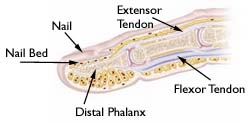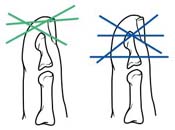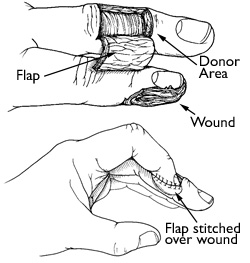
Fingertip Injuries and Amputations
Injuries to the fingertips are common in accidents at home, work, and play. They can occur when a fingertip slams in a car door, while chopping vegetables, or even when clearing debris from a lawnmower or snowblower.
Fingertip injuries can be crushing, tearing, or amputating injuries to the tips of fingers and thumbs. Injury can include damage to skin and soft tissue, bone (distal phalanx), or to the nail and nailbed. The tips of longer fingers tend to be injured more often because they are last to escape from harm's way.
 Normal anatomy of the fingertip.
Reproduced with permission from JF Sarwark, ed: Essentials of Musculoskeletal Care, ed 4. Rosemont, IL, American Academy of Orthopaedic Surgeons, 2010.
Normal anatomy of the fingertip.
Reproduced with permission from JF Sarwark, ed: Essentials of Musculoskeletal Care, ed 4. Rosemont, IL, American Academy of Orthopaedic Surgeons, 2010.
Fingertips are rich with nerves and are extremely sensitive. Without prompt and proper care, a fingertip injury can disrupt the complex function of the hand, possibly resulting in permanent deformity and disability.
A doctor should examine an injury to the tip of a finger or thumb.
First AidWhen preparing to see a doctor:
- Elevate the injury and apply ice to reduce bleeding and swelling
- Cover the fingertip wound with a dry, sterile dressing
- Immobilize the affected hand and wrist with a short splint
If a fingertip is completely cut off:
- Gently clean the amputated part with water (preferably saline)
- Cover it in gauze wrap
- Put it in a watertight bag
- Place the bag on ice
- Do not put the amputated part directly in ice. You could further damage it.
Take the amputated part with you to the emergency room.
Doctor ExaminationMedical History
To plan your treatment, it is important for your doctor to know the circumstances of the injury. Your doctor will want to know if you have any other medical problems, such as diabetes, and whether you take any medications. Your doctor may ask several of questions:
- How and when did the injury happen?
- Is the injury on your dominant hand?
- What do you do for a living and for recreational activities?
- Have there been other hand problems caused by conditions like osteoarthritis, diabetes, rheumatoid arthritis? Is your tetanus immunization current?
Physical Examination and Immediate Care
Your doctor may give you an injection (digital block anesthesia) to relieve pain in the affected finger. He or she will wash out (irrigate) the wound with a saline solution to make it easier to see the wound clearly. He or she will look for exposed bone, missing tissue, and injury to the nail.
After examining your finger, your doctor will thoroughly clean (debride) the wound, removing dead tissue and contaminants. This will reduce the chance for infection.
X-rays may be needed if your doctor suspects broken (fractured) bones. If blood has built up under the nail (subungual hematoma), your doctor may pierce the fingernail to relieve the pressure. You may also need an antibiotic and/or a tetanus shot to prevent infection.
TreatmentThe goal of treatment is to have a pain-free fingertip that is covered by healthy skin. Your hand should be able to feel, pinch, and grip, and you should be able to perform normal hand functions. Your doctor will also try to preserve the length and appearance of your finger.
How a doctor will treat a fingertip injury/amputation depends on the angle of the cut and the extent of the injury. Your general health and lifestyle will also be considered.
 (Left) Wounds made along the green lines can probably heal on their own.(Right) Wounds made along blue lines will probably need some sort of surgery to heal.
(Left) Wounds made along the green lines can probably heal on their own.(Right) Wounds made along blue lines will probably need some sort of surgery to heal.
Injury Without Exposed Bone
Minor tissue injury. If the fingertip wound is small and not deep enough to expose bone, it may close on its own. Your doctor may place a protective dressing over the wound with instructions to change the bandage regularly. He or she may recommend a splint to protect the area while it heals.
After about 24 to 48 hours, your doctor may recommend that you soak your finger daily in a solution of warm water and peroxide or betadine. After 48 hours, range-of-motion finger exercises may be started. Complete healing usually takes 3 to 5 weeks.
Larger tissue injury. If the wound to your fingertip is large and open, there may not be enough remaining skin to heal and cover the open area. If the wound is left to heal itself, the new skin around the wound may not be strong enough. In these cases, surgery is often required to ensure healing.
During surgery, a piece of skin (skin graft) is taken from another site, such as the palm of your hand, and used to cover the injury. Both the wound and the donor site are closed with stitches during the procedure.
Exposed Bone Injury
If the injury is large and also exposes bone, there may not be enough tissue around the wound to stitch the wound closed. Sometimes, the bone needs to be shortened so that your wound can be stitched closed. Shortening the bone usually does not hurt your ability to use your hand.
Reconstructive flap surgery. It may also be necessary to cover the wound with new skin, as well as the fat and blood vessels underneath. This is called reconstructive flap surgery. The flap of skin and soft tissue is taken from a healthy part of the same hand. Some areas of the hand that are used as donor areas are the injured finger itself, an uninjured finger, and the palm of the hand. A skin graft is used to cover the donor area and help it to heal.
In some cases, the flap is not fully removed from the donor area. The flap is sewn over the wound but it remains connected to the donor area. This is to ensure a healthy blood supply to the flap as it heals over the wound.
 In some reconstructive flap surgeries, the flap remains attached to the donor site during healing.
Reproduced with permission from Frassler PR: Fingertip Injuries: Evaluation and Treatment. J Am Acad Orthop Surg 1996;4:84-92.
In some reconstructive flap surgeries, the flap remains attached to the donor site during healing.
Reproduced with permission from Frassler PR: Fingertip Injuries: Evaluation and Treatment. J Am Acad Orthop Surg 1996;4:84-92.
Your doctor will apply a bulky dressing to protect the area while it heals. He or she may also apply a splint to help support your hand. Your uninjured fingers will be left free to exercise.
It typically takes a few weeks for the flap to heal over the wound and establish a blood supply from its new location. When this occurs, the flap will be detached from the donor area.
Replantation. If your injury has cut off a large part of your fingertip (the entire nail and a lot of the skin on the back of the finger), your surgeon may consider the pros and cons of reattaching the amputated part (replantation). This is a long, complicated surgical procedure.
Fingertip Amputations In Young Children
Doctors treat fingertip amputations somewhat differently in children younger than 6 years of age. After thoroughly cleaning and preparing an amputated fingertip, the surgeon may reattach it to the finger. The fingertip may continue to grow relatively normally, even if bone was exposed. This is especially possible in children younger than 2 years of age.
Surgical Considerations
In many cases, surgery can return a large degree of feeling and function to a fingertip injury. Like all surgeries, however, there are risks associated with surgery for fingertip injuries. These include:
- Infection
- Poor healing
- Loss of feeling or motion
- Adverse reactions to anesthesia
Full recovery from a fingertip injury may take several months. After the injury heals, mild to severe pain and sensitivity to cold may continue for a year or may even be permanent.
Your doctor may recommend physical therapy exercises to improve movement and strength in your hand. Heat and massage therapy, electric stimulation of the nerves in the hand, splinting, traction, and special wrappings to control swelling, are examples of additional therapies your doctor or physical therapist may suggest to promote healing.
Source: http://orthoinfo.aaos.org/topic.cfm?topic=A00014
